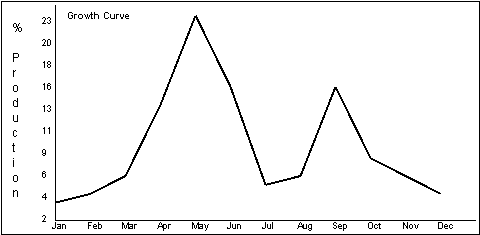Ranch Location:
West-central Texas
Operation:
Cow-calf, recreational hunting
Inventory:
 Shallow soil, limestone country
Shallow soil, limestone country
Live Oak, brush
Native pasture - mid- and short-grass community
- Highest percentage of forage growth in May and September
Average Annual Precipitation - 20 - 27 inches
(source: NRCS)
Critical Dates
Makes decisions when moving cattle. March 1st, June 1st are critical dates.
"You just don’t know for sure when this next rain is going to really get you through it or not. A springtime rain, you have a chance of getting by until maybe the first of June, but then the first of June, you’ve got to ...call the truck or something."
Monitoring Plan
Monitors moisture and grass canopy
"I just go in and see, when it’s time to move, when they get it grazed down, the canopy is grazed down, they’ve grazed over half of it, just look at it, see what I have left. And if I’ve got enough left to make it another 90 days, we kind of stay, if it doesn’t, it’s time to start doing something with them."
Before Drought
- Low stocking rate
"...they recommend in this country one animal unit to 12 acres. I figure an animal unit to 25 acres and that is way, way under what most would do."
- Water Development – mix of water sources
"I’ve built quite a few stock ponds…. we’re on a slope off the top of this hill here. We’ve got quite a few draws and we’ve got good drainage here."
"I got city water and then about three-four years ago, with the help of the NRCS and the soil and water conservation district, I got help and then with a neighbor we drilled a hickory aquifer well. My well is 3,400 feet deep."
"I’ve got an EQIP program right now that I’m involved with, [building] about another mile and a half of water line and about four more troughs and a reservoir. Then I’ll have my water complete for wildlife and for my cattle."
- Rotational grazing
- Pasture improvement
Grass improvement, brush control, overseeding
"One thing I have found, by clearing these areas, by putting improved grasses down and getting a good stand on them with some weed control, I have been able to bale some hay. It helps through these times."
- Enterprise diversification – hunting operation
"I know in two different situations, without that hunting, this ranch would have been close to folding."
During Drought
De-stock in a timely manner
"With the rotational grazing, what I’ve found by taking your stock off, being ready to take them off early enough, you leave enough vegetation on the ground to withstand a drought of some magnitude."
"Once you’ve gone through your pastures, we’ve done it twice, once you rotate and you come back through, you’ve just got to sell. There’s no way you can feed through a drought."
"You just start culling and just start culling. You start getting rid of your old cows, of course your open ones, and you just start going through and getting rid of them. Check your market, do the best you can."
Make the decision
"You’ve got to make the decision. And how many [to destock], part of that is guess, you know. But look at your country and that tells you, what you have growing out there left is what you have to live on. It’s just like money in the pocket. That’s just it. How many dollars you have worth of grass out there."
Lessons Learned
"I’ve done it myself too many times, held onto them, put more feed in them. I’ve fed two cow herds up in drought. Instead of having 100 head of cows, when I was through, the last time I had 15 cows paid for."
"I’ve been through these things enough years [to learn] that you just don’t come out by feeding them very long. There’s been two or three times in the last fifteen years that I had, I think maybe four or five cows on this whole place, and maybe four or five horses. It was empty other than wildlife. And it just has to be done if we’re going to make it."
"...It’s hard for people to do. They get married to a set of cattle."
Recommendations
- Debt
"Get out of debt as quick as you can. If you can, don’t start with debt."
- Inventory and improve pasture and water resources
"Evaluate each pasture, every one of them. Find out where you can improve your grass, where you can improve your water. [Get rid of brush.] And start small, you don’t have to do it all at once."
- Get help and cost-share assistance
"I would tell anybody to go and find whatever help they can through the NRCS, these EQIP programs."